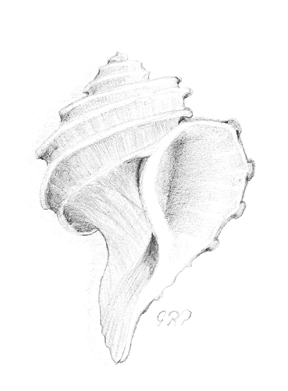|
|
 |
||||||||||
|
|||||||||||
|
|||||||||||
EcphoraThe little snail that climbed out of history to fameWhen visitors come from out of town, I like to take them to the The cliffs stretch from Fairhaven in Southern Anne Arundel County more than 30 miles south to Drum Point in Calvert County. They rise above the Chesapeake to over 100 feet in some places. The cliffs form “the most nearly complete sequence of marine Miocene sediments exposed in the East Coast of North America,” according to Wallace Ashby, writing in Fossils of Calvert Cliffs. In other words, there are a whole lot of shark’s teeth and other fossils in those cliffs and on the beach. During part of the Miocene — roughly 15 million years ago next Tuesday — a shallow sea covered the land as far east as Washington, D.C. The shells and bones of Miocene marine animals fell to the bottom and were covered by sand and mud. These deposits created the land forms of southern Maryland. The cliffs are the exposed cross section. The climate was warm then but would slowly turn quite cold, causing massive glaciers to cover much of the earth. Because so much water was captured by the glaciers, the sea receded, leaving a broad valley with the ancient Susquehanna River flowing through. For thousands of years, leading up to today, the climate has been in between. The glaciers receded, but instead of a shallow sea we have Chesapeake Bay, which fills the valley and continues to rise, causing the cliffs to further erode. Like many of my neighbors, I have a collection of fossilized sharks’ teeth, coral, stone crab claws, dolphin teeth and a few other Miocene odds and ends. Mostly I find small sharks’ teeth, about the size of a lentil. I have also found many russet-colored fragments of the Maryland state fossil, a snail called Ecphora gardnerae. A typical intact specimen would be two inches or larger and have four protruding ribs. Compared to sharks’ teeth, which are unbreakably tough, Ecphora are rather delicate, so it is hard to find them whole. I hear that good specimens are usually found in clumps of clay that have fallen out of the cliffs. Ecphora was one of the first New World fossils to be described and illustrated in a European scientific paper, where it was labeled marilandica. Good enough reason, I suppose, for the legislature to make an extinct snail our state fossil. |
|||||||||||
|
|||||||||||
|
|
|||||||||||
|
© COPYRIGHT 2007 by New Bay Enterprises, Inc. All rights reserved. |
|||||||||||

 beach for a few hours of fossil hunting. No matter what season, we always have a good time, and everyone goes home with free souvenirs from the world-famous Calvert Cliffs.
beach for a few hours of fossil hunting. No matter what season, we always have a good time, and everyone goes home with free souvenirs from the world-famous Calvert Cliffs.